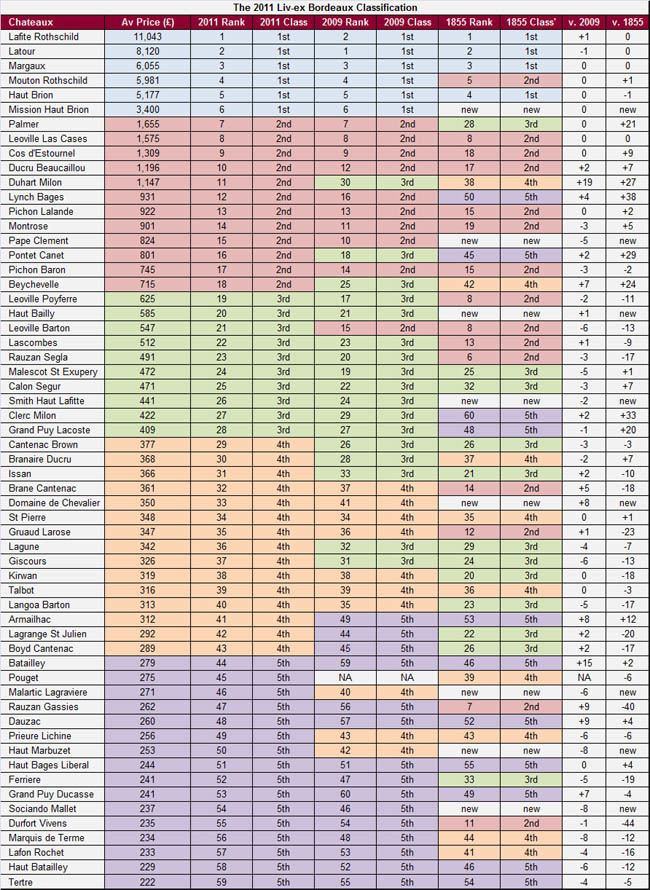 | ||
The Liv-ex Bordeaux Classification is a classification of Bordeaux wine compiled by the British internet and phone-based wine exchange, London International Vintners Exchange (Liv-ex) in March 2009, with an aim to recreate the Bordeaux Wine Official Classification of 1855 in a modern economic context, 154 years after the original compilation. Two years later, the market has shifted and the classification has been updated to reflect current trading conditions in 2011.
Contents
Criteria and Calculation
Based entirely on the level of prices, with the criteria of wines to be from the Left Bank (including Pessac-Leognan) and be produced in quantities of more than 2,000 cases, and not taking into account any second wines, the Liv-ex classification lists 60 estates, one fewer than that of 1855. The tiers were sectioned by the First Growths in the range of £2,000 a case and above, the Second Growths from £500 to £2,000, the Third Growths from £300 to £500, the Fourth Growths from £250 to £300 and the Fifth Growths from £200 to £250. The price averages were calculated from the period 2005–2009.
2011 Highlights
Among the chief differences from the 1885 classification is the placement of Château La Mission Haut-Brion among the First Growths, Château Lynch-Bages elevated from the fifth tier to the second, Château Palmer promoted a tier to become the top Second Growth. Lafite retakes its position as the top wine of the Left Bank - a position it surrendered to Latour in 2009. Lower down the list, Duhart Milon, Beychevelle and Pontet Canet graduate to Second-Growth status. Leoville Barton drops down to become a Third Growth.
Jack Hibberd of Liv-ex stated that the second wines of the estates were a complicating factor, "They obviously didn’t exist in 1855, so we decided to classify each property on the basis of their first wine. It is interesting to note, however, that if they were included as separate chateaux, 12 would make the cut, with Carruades de Lafite and Forts de Latour reaching the level of second growths."
1855 Classification | Agricultural Versus Market Economics
Original and new 1855 classifications are based on different market economics. 1855 Classification represents values of an agricultural economy, which winegrowers had a sense to, rightly, control. In great contrast any new classification occurs in a market economy, which marketers and market makers would have a sense to control. Marketing can attempt to add value to brands. Some might consider good marketing the act of getting more than the commodity or product deserves from a controlled agricultural market. What is interesting about the original 1855 Classification is that it represents trailing average prices for Bordeaux ecosystems and subsystems. In summary, the 1855 Classification is something of an economic museum; and reflects valuations without modern marketing attempts to influence the market economy. Changes to the original classification might be warranted to reflect changes in the physical environmental factors in Bordeaux.
